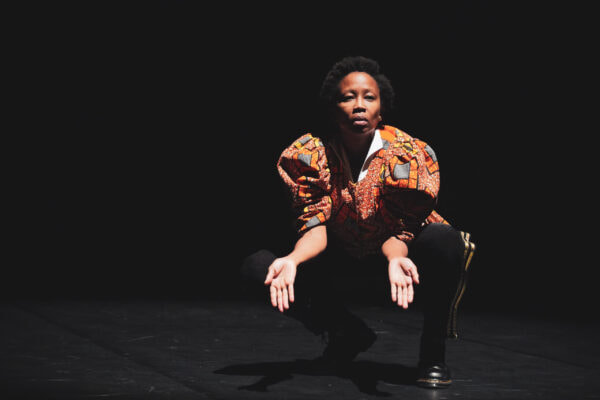|
Wanjiru Kamuyu performed the powerful "An Immigrant's Story" on Saturday at PS/21 in Chatham. The immigrant story is complicated. Each immigrant has a unique one that few in the new home country want to hear; so they walk among their new country folks in fear. They are “the other” and they remain as such until they can blend. And before they do, they must be wary.
That’s the message behind Wanjiru Kamuyu’s “An Immigrant’s Story,” a powerful solo performed by Wanjiru Kamuyu on Saturday at PS/21 in Chatham. In an evening-length work, this dancer, singer and storyteller from Kenya and France explores the careful tight-rope immigrants tread – one where they inhabit land that many don’t want them to live. It's an important, timely topic that Kamuyu breaches. And I'm glad she is doing it as Kamuyu is an engaging artist who, in this work, grabs her audience’s attention immediately with her voice that shot through the darkness with a longing for a home that is lost. When the lights on the stage rise to just a thin line in which she stands, one sees a person who struggles. She tears at her heart, looking strangled. She holds out her hands, begging for acceptance. She is trapped with little room to maneuver. As she runs, her colorful, African-pattern top, becomes tattered. So too do her pants. And when her costumes, designed by Brigit Neppl, transforms into a ripped robe of faded material, one sees the pain of being stripped of more than a home. Familiar landscapes, friendships, language, acceptance are lost. The stage design is stark. It is rimmed with overturned chairs – basically signaling that one is not welcome. You cannot sit and stay in an upside-down chair. The lighting, by Cyril Mulon, is also telling. It switches to boxes – as if an immigrant is boxed into a persona. She stands in one to tell the story of an African teen coming to America – and the racism she met. That marginalization did not emanate from White people but Blacks who called her names like Jungle Bunny and taunted her by saying she lived like Tarzan, topless with her bottom hanging out. They even, shockingly, said the transatlantic slave trade kept them from that – a shocking notion for any person of color to contemplate. At one point, Kamuyu walks off the stage and glides slowly through an aisle of patrons, making discomfort part of the experience. Members of the audience she slips by stand, lean back, shift in the closeness to this stranger. Her pass through in the house, with her head held high and eyes searching, is overlaid with her voice that speaks of the privilege of sitting up front with others of your same race, perhaps same ethnic background. She spoke about how those in the back are not even worthy of consideration. Those in the front row are who matter. It was a strong indictment on all of us there, mainly because it’s true. When she returned to the stage, she spoke of immigrant stories – those of all people -- as created by Laetitia Ajanohun. The last was of a Russian living in Sweden. Though that person made a life in Sweden, they balk at talking about their roots, but whimsically admit they yearn to sit by a river near their old home. It was heartbreaking. What those who vilify immigrants miss is the immigrants might not want to be here or another country either. And at a time when immigrants are unfairly targeted, Kamuyu wants people to know that. I hope more people listen.
0 Comments
Leave a Reply. |
Wendy
|

 RSS Feed
RSS Feed
